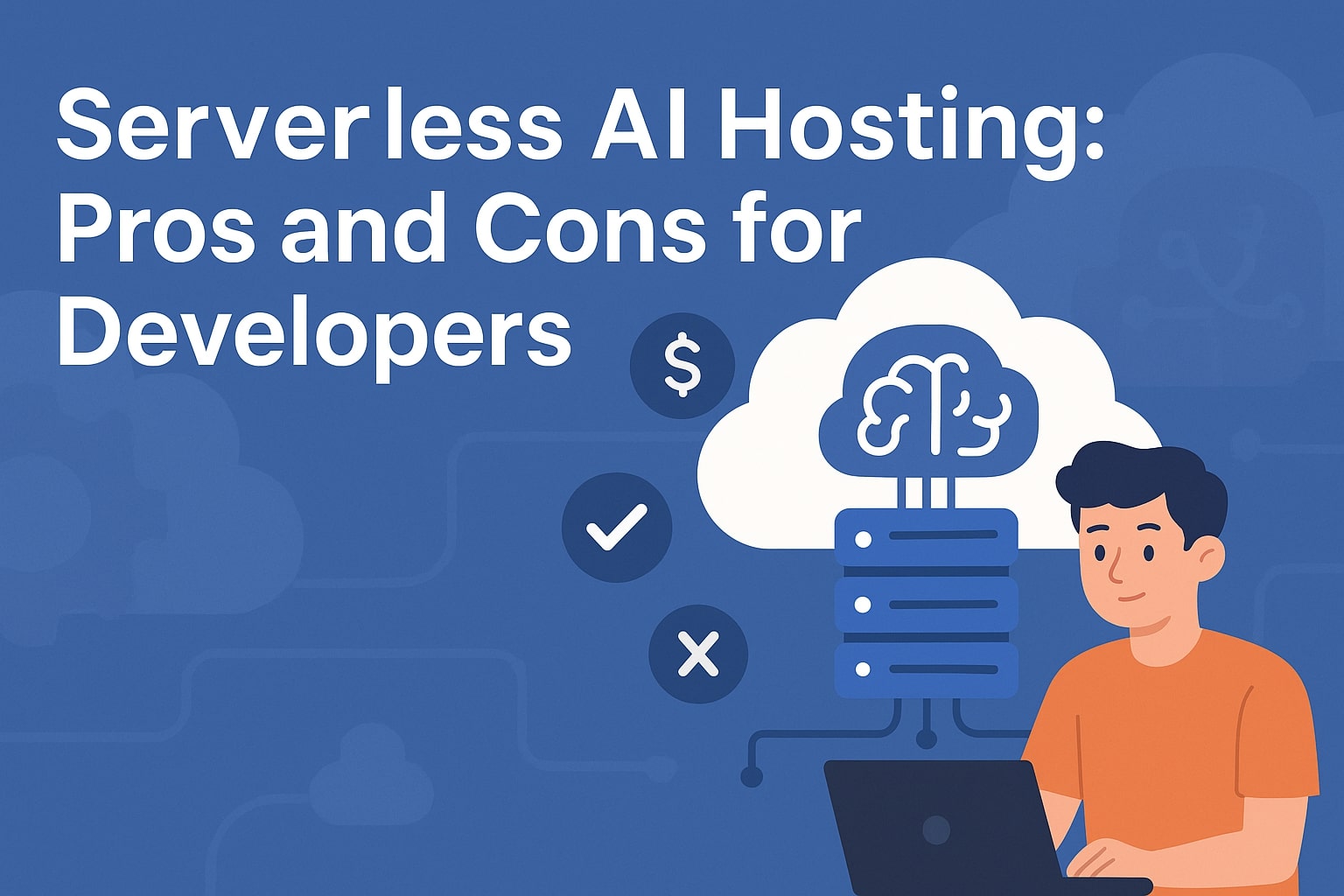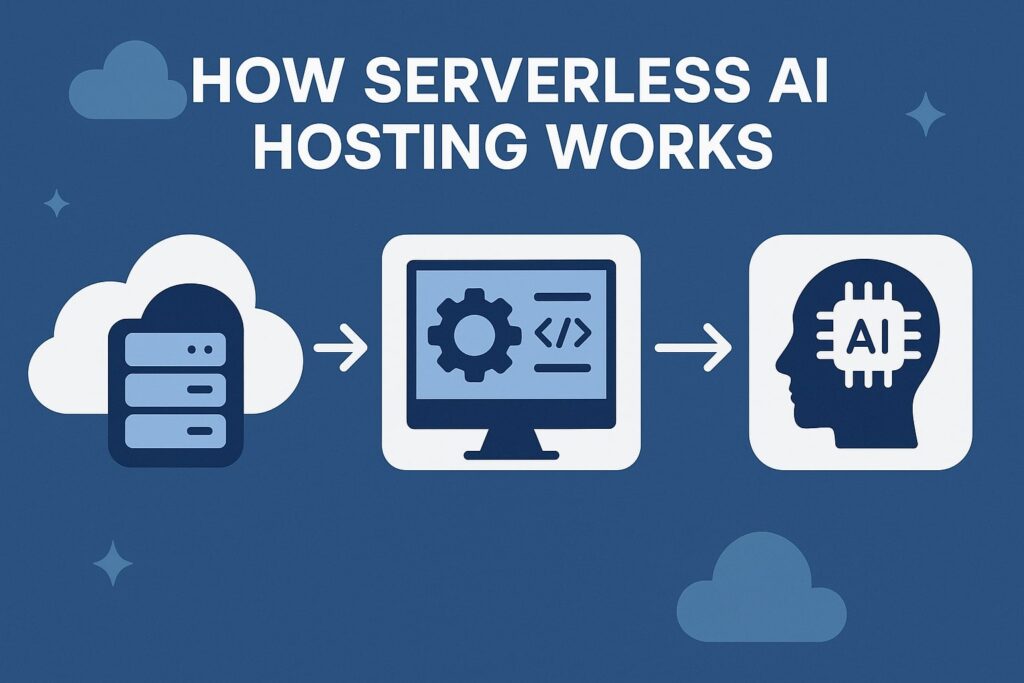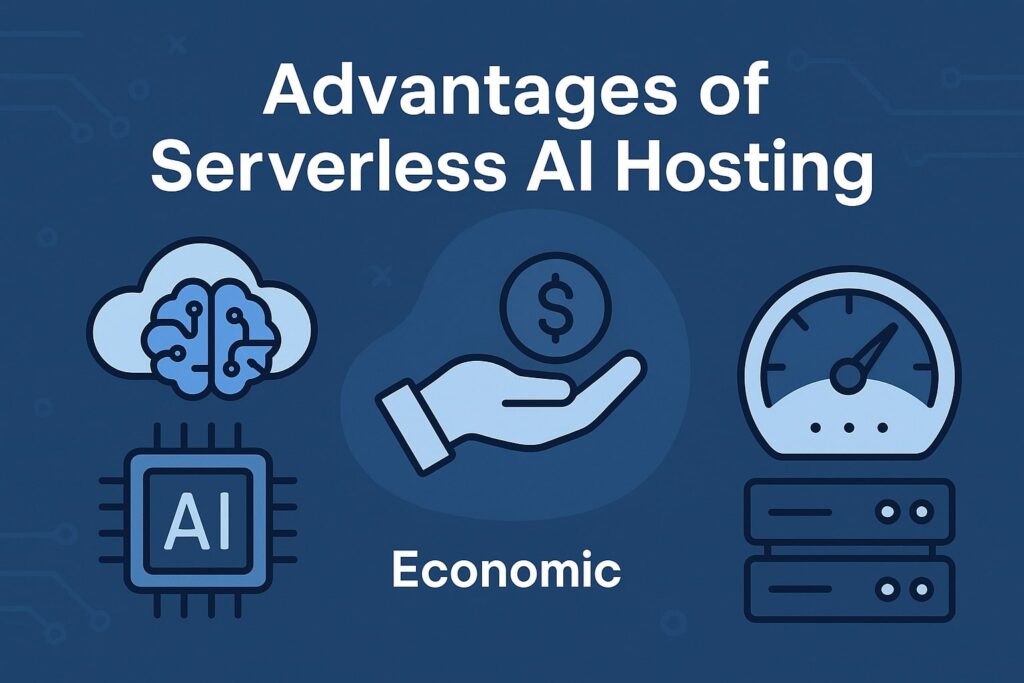
By hostmyai October 14, 2025
Serverless AI Hosting is a deployment model where your AI workloads—such as large language model (LLM) inference, vision models, or vector search—run on fully managed, on-demand infrastructure that automatically scales up when requests arrive and scales to zero when idle.
Instead of provisioning and babysitting servers (or even containers), you package your model and code, define an endpoint, and let the provider handle scaling, availability, patching, and capacity planning.
In 2025, leading cloud platforms offer concrete flavors of Serverless AI Hosting: Google Cloud Run now supports NVIDIA GPUs with per-second billing and scale-to-zero, making it a truly serverless option for GPU inference.
That matters because many AI models need accelerators to hit latency targets; Cloud Run bridging “serverless + GPU” closes a gap that used to push teams toward always-on clusters.
By contrast, Amazon’s SageMaker Serverless Inference is designed for bursty, intermittent CPU workloads and handles provisioning behind the scenes—but as of the latest docs it does not support GPUs, steering GPU-hungry inference toward other SageMaker options (real-time endpoints) or AWS Bedrock’s managed model APIs.
This distinction is crucial when you choose platforms for “Serverless AI Hosting”: if your model is small and latency-tolerant, serverless CPU may fit; if you need accelerators, pick serverless that explicitly advertises GPU support.
Cloudflare’s Workers AI also positions itself as a serverless inference platform at the edge, expanding GPU coverage to hundreds of cities for low-latency global access.
These differences show that “serverless” is an umbrella term; the exact capabilities (GPUs, cold starts, observability) vary significantly by provider.
How Serverless AI Hosting Works

Under the hood, Serverless AI Hosting relies on an event-driven control plane. When an HTTP request hits your endpoint, the platform schedules your function or container onto the underlying compute.
With GPU-backed offerings (for example, Cloud Run with NVIDIA L4/L40-class GPUs), the scheduler mounts accelerators just-in-time, spins up instances, and tears them down after inactivity—charging you by the second.
This “scale to zero + pay-as-you-go” model is the core promise of serverless and is increasingly true even for accelerators, not just CPUs. For developers, it yields simpler operations: push an image or model artifact, specify memory/GPU, and let the platform autoscale.
For AI specifically, you’ll combine this with model registries, artifact stores, and secrets. On Microsoft Azure’s side, standard/serverless deployments in Azure Machine Learning/Azure AI expose a consistent “Model Inference API” for foundation-model endpoints and third-party models via Marketplace, abstracting away a lot of infra details.
AI apps rarely stop at raw inference. Retrieval-augmented generation (RAG) and semantic search add a vector database, which increasingly comes as a serverless managed service as well.
Pinecone and Weaviate both offer serverless vector storage with usage-based pricing. That means you can architect a fully serverless AI stack: a serverless inference endpoint for the model, a serverless vector database for embeddings, and event-driven glue (queues, schedulers) around them.
The benefit is elasticity and operations simplicity; the trade-off is less control over the underlying instances, plus cost models that can be harder to predict without careful monitoring.
Advantages of Serverless AI Hosting

1) Developer Productivity and Faster Time-to-Value
The biggest upside of Serverless AI Hosting is that it removes the heavy lifting of capacity planning, cluster setup, GPU driver maintenance, and autoscaling logic. On Google Cloud Run, GPUs are not just supported but billed per second, and instances can scale to zero—so you can ship a model behind a URL without wrestling with Kubernetes.
On Azure, the standard/serverless deployment path and the Model Inference API simplify consuming hosted foundation models or marketplace models with a uniform surface.
Instead of building MLOps pipelines to keep inference online, you’re free to focus on data quality, prompt orchestration, RAG pipelines, and product features. For small teams, that’s the difference between spending weeks on infra and shipping in days. For larger orgs, it standardizes deployment patterns across teams.
Another productivity boost comes from pairing serverless inference with serverless vector databases. Pinecone’s serverless offering eliminates index sizing and cluster management, while Weaviate’s Serverless Cloud wraps vector search in a fully managed SaaS.
This reduces the operational surface area of AI stacks—no replicas to tune, no manual shard allocation, and fewer on-call pagers. The net: shorter lead times, easier experiments, and quicker iteration on prompts, guardrails, and evaluation.
2) Elastic Scaling for Spiky or Seasonal Demand
Serverless AI Hosting shines for bursty traffic patterns. If your app experiences morning spikes, campaign-driven surges, or irregular batch inference, you don’t want to pay for idle accelerators.
Cloud Run’s GPU support explicitly enables scale-to-zero and elastic warm-ups on accelerators, aligning cost with demand. Meanwhile, services like AWS Bedrock price per token or request for managed models, so you don’t have to guess how many GPUs you’ll need for a promo week; you consume an API and pay for usage.
Azure’s serverless/standard endpoints automate allocation behind the scenes, and many serverless vector databases bill for operations and storage rather than provisioned capacity. This elasticity is exactly what “serverless” set out to deliver, now extended to AI.
3) Cost Alignment and Pay-Per-Use Economics
Traditional GPU clusters are powerful but expensive to run 24/7, especially when traffic is uneven. Serverless AI Hosting flips that equation with granular billing and scale-to-zero. Google highlights per-second billing for GPU workloads on Cloud Run and zero idle cost when no requests arrive.
On the vector side, Pinecone/Weaviate publish pricing that scales with stored dimensions, reads/writes, and service tiers—making it easier to tie costs directly to usage.
On AWS, Bedrock pricing varies by model and modality; you can choose on-demand or batch (often cheaper) and avoid provisioning headaches.
The trade-off is that price visibility can still be complex—optimizing prompt tokens, choosing batch vs. real-time, and keeping an eye on embedding churn are essential to preventing surprise bills.
4) Global Latency and Edge Proximity
Latency matters for conversational UX and real-time assistants. Cloudflare’s Workers AI runs inference across a globally distributed edge with GPUs in 180+ cities, which helps push execution closer to end users.
Edge-first serverless can shrink round-trip times and improve perceived responsiveness, especially when paired with local caching and streaming responses. Not every workload fits the edge (large batch jobs still belong in regional backends), but for user-facing inference, having compute near users is a meaningful advantage.
5) Managed Security, Patching, and Compliance
Serverless platforms handle OS patching, runtime updates, dependency pinning, and parts of the shared-responsibility model. Azure’s managed approach integrates with role-based access and marketplace subscriptions; you can rely on provider-level controls rather than building everything from scratch.
With vector databases as managed services, backups, replication, and certain compliance features are built in. The upshot: fewer attack surfaces for your team to misconfigure and quicker alignment with enterprise policy—though, as we’ll see, there are still gaps like VPC/isolation options on some serverless SKUs you should understand up front.
Limitations and Trade-Offs of Serverless AI Hosting

1) Cold Starts and Warm-Up Latency
Cold starts are the most visible trade-off in Serverless AI Hosting. When an endpoint has scaled to zero, the next request triggers provisioning and model initialization, adding seconds to the first response.
With CPU serverless, cold starts were manageable; with GPU and large weights, they’re more pronounced. Cloud Run’s model still delivers scale-to-zero on GPUs, which is powerful, but you’ll need warm-up tactics (periodic pings, min-instances if available, smaller/quantized models) to control tail latencies.
If strict P99 latency is contractual, consider a hybrid pattern: a small number of always-on replicas for baseline load plus serverless spillover for spikes.
2) GPU Availability and Feature Gaps
Not every “serverless” SKU supports GPUs. As of current AWS documentation, SageMaker Serverless Inference excludes GPUs, which forces GPU workloads toward alternative deployment options (SageMaker real-time endpoints, EKS, or Cloud Run with GPUs on GCP) or toward managed model APIs like Bedrock.
Workers AI offers edge inference with expanding GPU coverage, but model sizes and feature sets vary by region. When evaluating Serverless AI Hosting, confirm GPU types, regions, concurrency limits, and whether model containers can access low-level drivers/libraries you require. Mismatches here are a common source of surprises during go-live.
3) Less Control and Limited Observability
Serverless abstracts the runtime, which is a blessing for ops—but you trade away certain controls. Kernel-level tweaks, custom networking, and advanced debugging hooks are constrained.
You depend on provider logs/metrics and may have fewer knobs for GPU memory partitioning or NUMA placement. Some serverless endpoints don’t support VPC configuration or network isolation, limiting how you integrate with private data planes.
If you require deep profiling (e.g., CUDA timeline analysis) or custom drivers, a dedicated cluster can still be the better fit. Always check the provider’s “unsupported features” list for serverless endpoints before you commit.
4) Pricing Complexity and Vendor Lock-In
Usage-based billing is great—but parsing it can be tricky. Bedrock pricing varies by model provider and modality; batch is cheaper than on-demand for some workloads; and provisioned throughput has different economics than truly “serverless” pay-per-request.
Vector databases charge for dimensions, reads/writes, and SLAs. Over time, these moving parts can make apples-to-apples ROI comparisons hard, and switching providers later can be costly because of SDK differences, embeddings lock-in, and data egress.
Establish cost guardrails (budgets, anomaly alerts) and track unit economics (cost per 1K tokens, cost per query) from day one.
When Serverless AI Hosting Fits—and When It Doesn’t
Serverless AI Hosting is ideal when your traffic is spiky, your team is small, or your time-to-market matters more than fine-grained infra control.
Typical sweet spots include: chat assistants with variable usage; prototype features you expect to iterate on rapidly; seasonal personalization; and customer-support copilots where occasional cold-start overhead is acceptable.
Cloud Run with GPUs makes this viable even for image generation or medium-sized LLMs, as long as you can tolerate warm-up at low load and use min-instances or warming to control tail latency. Vector databases as serverless services let you scale RAG without planning shards.
On the other hand, always-hot, ultra-low-latency workloads with strict P99 SLOs, massive batch windows with predictable throughput, or highly specialized CUDA/kernel requirements may be better on dedicated clusters or managed real-time endpoints.
If you require VPC peering, strict network isolation, custom drivers, or deep observability, check serverless feature matrices carefully. For example, SageMaker Serverless Inference lacks certain enterprise features (GPUs, VPC configuration), so teams needing those pivot to real-time endpoints or alternative platforms.
The best practice is to start serverless for speed, then graduate portions of traffic to dedicated infrastructure when cost or control demands it.
Design Patterns for Serverless AI Hosting
Pattern A: RAG with a Serverless Vector Database
A common pattern pairs serverless inference with Pinecone or Weaviate. Your flow: ingest content → generate embeddings → upsert into a serverless vector DB → at query time, embed the user prompt → retrieve top-K context → call the model on a serverless inference endpoint.
This architecture scales to zero for both inference and search operations while keeping ops simple. With Pinecone’s serverless pricing and Weaviate’s Serverless Cloud, you don’t manage clusters, shards, or replicas—just data and queries. You’ll still design for throughput (batch upserts, async pipelines), but infra is mostly hands-off.
Pattern B: Edge Inference for Low-Latency UX
If you need snappy UX worldwide—autocompletion, moderation, or reranking—run lightweight models at the edge. Cloudflare Workers AI pushes inference close to users with GPUs in 180+ cities, reducing round-trip latency.
You can combine this with regionally pinned vector stores or caches for privacy and performance. Keep in mind model size limits and regional availability; heavier models may still live in regional backends like Cloud Run GPUs, with Workers AI handling pre-/post-processing, routing, or safety checks.
Pattern C: Hybrid “Hot Pool + Serverless Burst”
To meet strict P99 while containing cost, run a small pool of always-on GPU replicas (cluster or managed real-time endpoints) and burst to serverless during spikes.
For example, maintain two hot replicas for baseline load, and route overflow to Cloud Run GPU services that scale elastically. This hedges cold-start risk without paying for idle capacity 24/7. In parallel, use token budgets and batch APIs (e.g., where Bedrock offers cheaper batch pricing) for offline jobs.
Cost Optimization Playbook for Serverless AI Hosting
First, measure unit economics: cost per 1K tokens, cost per request, cost per successful session, and vector cost per 1K embeddings stored/queried. Cloud Run’s per-second GPU billing and scale-to-zero help align expenses with traffic; use that to your advantage by shutting down idle services.
On Bedrock, pick models and modalities carefully and consider batch inference where it’s discounted. For vector stores, keep embeddings lean: reduce dimensionality if acceptable, deduplicate content, and set TTLs on stale data. Avoid generating multiple embeddings per doc unless experimentation proves a measurable win.
Second, optimize latency to reduce over-provisioning. Warm critical endpoints with scheduled pings; where available, configure minimum instances for peak hours and allow scale-to-zero overnight. Quantize or distill models to shrink load times and GPU memory footprints.
Third, control egress: co-locate inference and vector DB in the same region and minimize cross-region hops, especially if your stack includes third-party APIs. Finally, adopt transparent dashboards: Bedrock and vector DB pricing can be nuanced; cost visibility tools and anomaly detection alerts will prevent bill shock as traffic climbs.
Performance Tuning and Reliability for Serverless AI Hosting
Start with cold-start mitigation: pre-load tokenizer vocabularies; use lazy loading only where it demonstrably helps; and consider lighter checkpoints for “first token” speed. If your platform supports it, set a small number of warm instances during business hours.
Use streaming outputs to improve time-to-first-token, masking back-end latency. For GPU serverless, keep container images minimal, pin compatible CUDA/cuDNN runtimes, and avoid large dependency graphs that slow cold boot.
Implement observability with distributed tracing around vector retrieval, model invocation, and post-processing. Record prompt + retrieval stats (token counts, retrieved doc lengths, vector distances) to understand where time and cost go.
Introduce circuit breakers and fallbacks: if vector search is slow, route to a smaller local reranker or skip retrieval for known FAQs. Finally, practice progressive enhancement: return a quick short answer while the full chain composes richer context in the background (when product UX allows), thereby smoothing perceived latency for users.
Security and Data Governance in Serverless AI Hosting
Security in Serverless AI Hosting is a shared-responsibility story. Providers manage the runtime, patching, and much of the perimeter; you’re responsible for secrets, data residency, and application-level controls.
Azure’s model catalog and marketplace integration brings role-based access and subscription workflows that help you govern who can deploy or consume models under specific terms.
On the flip side, some serverless inference SKUs restrict VPC networking or private endpoints; for example, SageMaker Serverless Inference documents multiple unsupported features (including GPUs and VPC configuration), which may affect how you connect to private data stores.
Always verify whether your chosen serverless endpoint supports network isolation, private links, and region-specific residency to meet compliance.
For vector databases, review encryption at rest/in transit, access tokens, and audit logs. If you’re handling PII or regulated data, consider bring-your-own-key (BYOK) capabilities and region pinning.
Edge inference platforms improve latency but may process data in many jurisdictions; ensure your data-handling policies (redaction, tokenization) match where the compute runs, and confirm regional controls or opt-out settings when required.
Quick-Start: Platform-Specific Notes
Google Cloud Run (Serverless GPUs)
- Containerize your model server (FastAPI/Flask or a Triton-based image).
- Enable GPU on Cloud Run, pick an appropriate GPU type, memory, and concurrency.
- Push your image to Artifact Registry and deploy with min instances (optional) to mitigate cold starts.
- Add Cloud Endpoints/IAM as needed; use Cloud Scheduler to keep critical endpoints warm.
You’ll benefit from per-second GPU billing and scale-to-zero, which is why Cloud Run has become a go-to for Serverless AI Hosting on accelerators.
Azure Machine Learning / Azure AI (Standard/Serverless Inference)
Use the Azure ML CLI/SDK to create a ServerlessEndpoint or standard deployment. Subscribe to marketplace models if needed, confirm region availability, and deploy.
You’ll get a consistent Model Inference API across Microsoft and partner models, which reduces SDK sprawl and simplifies swapping models later. Tie deployments to RBAC and track costs across workspaces.
Cloudflare Workers AI (Edge Inference)
Deploy inference that benefits from global proximity—classification, reranking, moderation, or lightweight generation. Workers AI now runs on GPUs across 180+ cities, so you can execute model calls close to users.
Use KV or D1 for caching and simple state, and route heavy model calls to regional GPU endpoints if the model is too large for the edge footprint.
FAQs
Q.1: Is Serverless AI Hosting viable for GPU-intensive LLMs?
Answer: Yes—on platforms that explicitly offer GPU serverless. Google Cloud Run provides serverless GPUs with pay-per-second billing and scale-to-zero, enabling on-demand accelerators without a 24/7 cluster. Cloudflare Workers AI also brings GPUs to the edge with global reach.
On AWS, SageMaker Serverless Inference does not support GPUs; you would use real-time endpoints for GPUs or managed APIs like Bedrock. Always check the platform matrix for GPU type, memory, concurrency, and regional availability before committing.
Q.2: How do I control cold starts?
Answer: Use platform features like min instances or scheduled warmers for critical paths. Keep container images slim and models quantized or distilled to reduce load time.
If strict P99 SLOs are needed, run a hot pool of always-on replicas and let serverless burst for spikes. Streaming responses improve perceived latency even when a cold start occurs.
Q.3: What about vector databases—can those be serverless too?
Answer: Yes. Pinecone and Weaviate offer serverless vector databases with usage-based pricing, removing the need to size clusters.
This pairs naturally with serverless inference for end-to-end elasticity. Understand pricing knobs (dimensions stored, R/W operations, SLA tiers) and set budgets/alerts to avoid surprises at scale.
Q.4: Is serverless more expensive than running my own GPU cluster?
Answer: It depends on utilization. For spiky or unpredictable workloads, serverless often wins because you avoid idle cost (e.g., Cloud Run’s scale-to-zero and per-second billing).
For consistently high, predictable throughput where GPUs stay >70–80% utilized, dedicated clusters or managed real-time endpoints can be more cost-effective. Use batch options (e.g., Bedrock batch) where applicable.
Q.5: How portable is my stack across clouds?
Answer: Using open interfaces (OpenAPI/HTTP), common serving runtimes, and standardized embeddings helps, but differences remain: provider SDKs, authentication, observability, and vector-DB billing models.
Azure’s consistent Model Inference API reduces fragmentation within Azure. For broader portability, use abstraction layers in your app and keep embedding pipelines decoupled from a single vendor’s index.
Q.6: Are there compliance or networking limitations?
Answer: Some serverless offerings restrict VPC networking, private endpoints, or network isolation modes.
For instance, SageMaker Serverless Inference lists unsupported features such as GPUs and VPC configuration, so sensitive data paths may require an alternative deployment (real-time endpoints/cluster). Validate data residency and edge execution locations if using globally distributed edge inference.
Conclusion
Serverless AI Hosting compresses the distance between “idea” and “running in production.” The model is simple: you bring code and weights; the platform brings elastic compute, autoscaling, and managed operations.
In 2025, that promise increasingly extends to GPUs, not just CPUs: Google Cloud Run makes GPU serverless real with per-second billing and scale-to-zero, while Cloudflare Workers AI pushes inference to the global edge.
Pairing serverless inference with serverless vector databases like Pinecone or Weaviate yields a full stack that scales with demand and minimizes ops toil.
But “serverless” isn’t a silver bullet. Cold starts can hurt tail latencies. Feature gaps (such as missing GPUs or strict networking controls) can block some enterprise scenarios. Pricing can be nuanced across models, tokens, and vector operations.
The pragmatic path is to adopt Serverless AI Hosting where it accelerates delivery—spiky traffic, fast-moving product teams, and globally distributed apps—and keep the option to graduate hot paths to dedicated infrastructure if/when utilization justifies it.
With clear SLOs, cost guardrails, and a few proven patterns (RAG + serverless vector DB, edge inference for latency, hybrid hot-pool + serverless burst), you’ll capture the best of both worlds: speed today and control tomorrow.